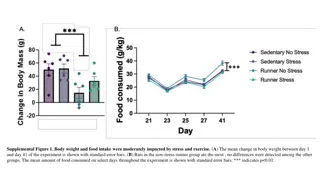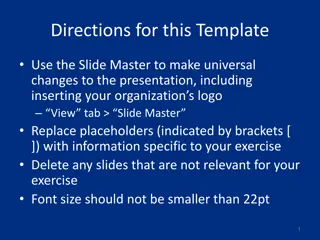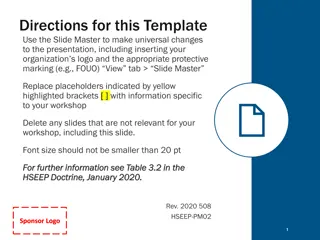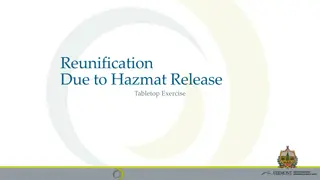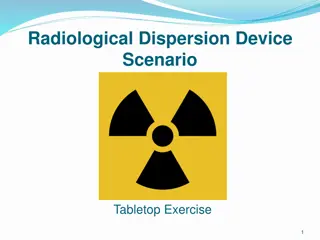Teachings for Exercise
Dive into the teachings for exercise through practical applications and insightful guidance to boost your fitness journey. Discover effective strategies and motivation to enhance your workout routine and achieve your health goals with ease. Explore new approaches to exercise that will inspire and empower you to make lasting improvements in your physical well-being.
Download Presentation

Please find below an Image/Link to download the presentation.
The content on the website is provided AS IS for your information and personal use only. It may not be sold, licensed, or shared on other websites without obtaining consent from the author.If you encounter any issues during the download, it is possible that the publisher has removed the file from their server.
You are allowed to download the files provided on this website for personal or commercial use, subject to the condition that they are used lawfully. All files are the property of their respective owners.
The content on the website is provided AS IS for your information and personal use only. It may not be sold, licensed, or shared on other websites without obtaining consent from the author.
E N D
Presentation Transcript
Teachings for Exercise 2D Teachings for Exercise 2D
?? ?? ?? ?? + Measures of location and spread A measure of spread is a value which indicated how spread out the data set is. Examples include the range and interquartile range. The range is the difference between the largest and smallest values, and measures the spread of all the data The interquartile range is the difference between the upper and lower quartiles, and measures the spread of the middle 50% of the data The interpercentile range is the difference between 2 given percentiles 2D
?? ?? ?? ?? + Measures of location and spread Mass, m (t) Frequency A measure of spread is a value which indicated how spread out the data set is. Examples include the range and interquartile range. 13 4.0 ? < 4.5 23 4.5 ? < 5.0 31 5.0 ? < 5.5 The range is the biggest possible value subtract the smallest possible value 34 The table to the right shows the masses (tonnes) of 120 African elephants. 5.5 ? < 6.0 19 6.0 ? 6.5 6.5 - 4.0 = 2.5 Find estimates for: a) The range b) The interquartile range c) The 10th to 90th percentile range ?.? 2D
?? ?? ?? ?? + Measures of location and spread Mass, m (t) Frequency A measure of spread is a value which indicated how spread out the data set is. Examples include the range and interquartile range. 13 4.0 ? < 4.5 13 23 4.5 ? < 5.0 36 31 5.0 ? < 5.5 67 For ?1 34 The table to the right shows the masses (tonnes) of 120 African elephants. 5.5 ? < 6.0 101 ? 4 19 6.0 ? 6.5 120 =120 = 30? value 4 Find estimates for: a) The range b) The interquartile range c) The 10th to 90th percentile range Now use linear interpolation ?.? ?? ?? ?? ?? + Sub in values 17 23 0.5 ??= ?.?? = 4.5 + Calculate = 4.87 2D
?? ?? ?? ?? + Measures of location and spread Mass, m (t) Frequency A measure of spread is a value which indicated how spread out the data set is. Examples include the range and interquartile range. 13 4.0 ? < 4.5 13 23 4.5 ? < 5.0 36 31 5.0 ? < 5.5 67 For ?3 34 The table to the right shows the masses (tonnes) of 120 African elephants. 5.5 ? < 6.0 101 3? 4 19 6.0 ? 6.5 120 =360 = 90? value 4 Find estimates for: a) The range b) The interquartile range c) The 10th to 90th percentile range Now use linear interpolation ?.? ?? ?? ?? ?.?? ?? + Sub in values 23 34 0.5 ??= ?.?? ??= ?.?? = 5.5 + Calculate ?.?? ?.?? = ?.?? = 5.84 2D
?? ?? ?? ?? + Measures of location and spread Mass, m (t) Frequency A measure of spread is a value which indicated how spread out the data set is. Examples include the range and interquartile range. 13 4.0 ? < 4.5 13 23 4.5 ? < 5.0 36 31 5.0 ? < 5.5 67 For ?10 34 The table to the right shows the masses (tonnes) of 120 African elephants. 5.5 ? < 6.0 101 10? 100 19 6.0 ? 6.5 120 =1200 100 = 12? value Find estimates for: a) The range b) The interquartile range c) The 10th to 90th percentile range Now use linear interpolation ?.? ?? ?? ?? ?.?? ?? + Sub in values 12 13 0.5 ???= ?.?? = 4.0 + Calculate = 4.46 2D
?? ?? ?? ?? + Measures of location and spread Mass, m (t) Frequency A measure of spread is a value which indicated how spread out the data set is. Examples include the range and interquartile range. 13 4.0 ? < 4.5 13 23 4.5 ? < 5.0 36 31 5.0 ? < 5.5 67 For ?90 34 The table to the right shows the masses (tonnes) of 120 African elephants. 5.5 ? < 6.0 101 90? 100 19 6.0 ? 6.5 120 =10800 100 = 108? value Find estimates for: a) The range b) The interquartile range c) The 10th to 90th percentile range Now use linear interpolation ?.? ?? ?? ?? ?.?? ?? + Sub in values 7 ???= ?.?? ???= ?.?? = 6.0 + 19 0.5 Calculate ?.?? ?.?? = ?.?? = 6.18 2D







